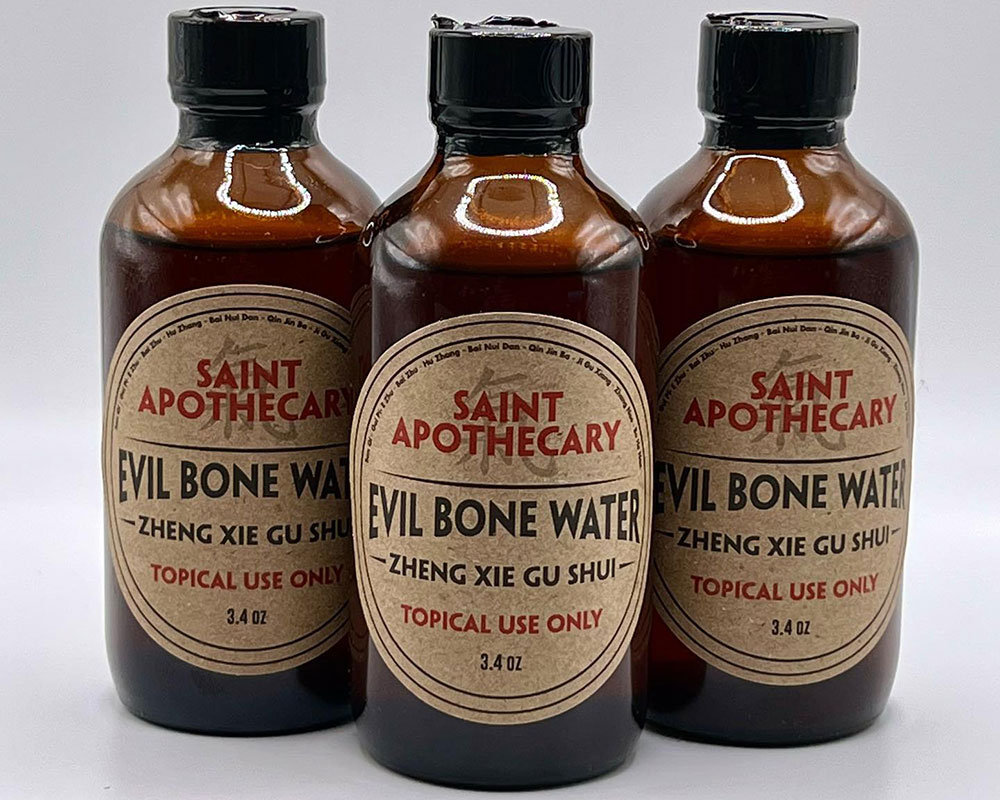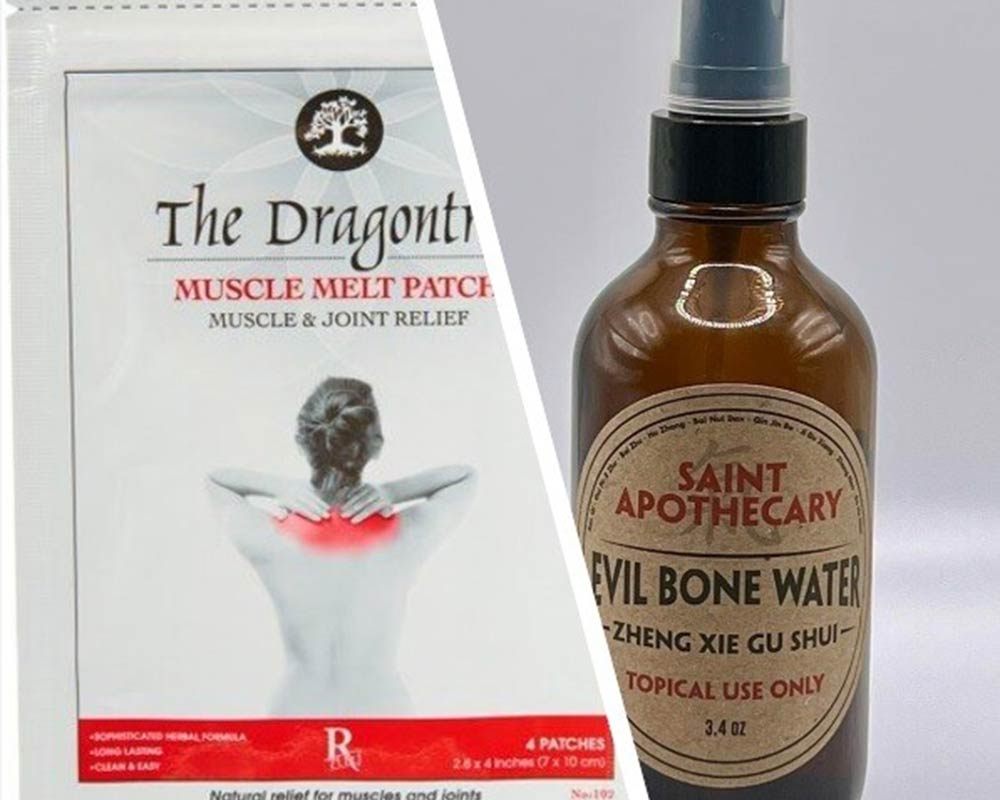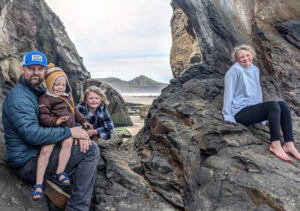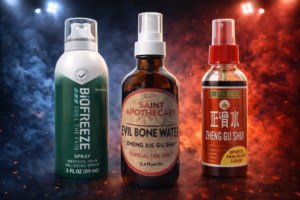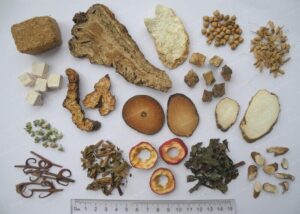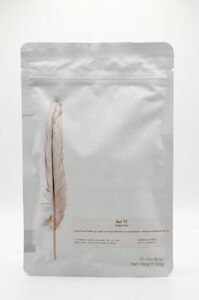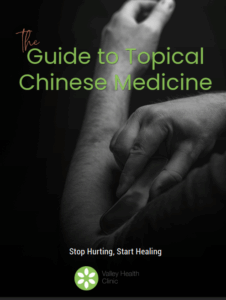Question From A Customer
After receiving an email from a valued customer seeking advice about hip bursitis, sharing this knowledge with our wider community seemed fitting.
The customer wrote, “We purchased Evil Bone Water for ourselves, and while it helped my knee pain, my husband, suspected of suffering from hip bursitis, still relies on over-the-counter pain relievers. Any suggestions?”
Hip bursitis is indeed a common condition affecting numerous individuals worldwide. Understanding this ailment, its causes, and effective treatments are helpful in managing the associated pain and discomfort.
So let’s delve into the specifics of hip bursitis, exploring at-home treatment methods, including the application of Evil Bone Water (EBW) and how to get the most out of its application. I will also offer tips for managing this condition and touch upon other potential diagnoses for hip pain. So, let’s dive in!
What is Hip Bursitis? Symptoms, Causes, and Diagnosis
The bursa is a small, fluid-filled sac that provides cushioning between bones and surrounding soft tissues in the joints. Hip bursitis often arises when the bursa over the greater trochanter (the protruding bone on the side of your hip) inflames due to overuse or injury, leading to significant discomfort.
The largest hip bursa lies beneath the tensor fascia lata and gluteus maximus as they unite to form the Iliotibial band ( often called the IT band) directly over the greater trochanter.
Trochanter bursitis usually surfaces gradually from overuse but can also result from a direct, traumatic fall onto the hip. This typically happens when an individual significantly increases their walking volume or carries heavy loads while walking. In the clinic, I see this happening most with Disneyland vacations, hiking with a heavy, backpack, or even lengthy Costco shopping trips.
Identifying the symptoms of hip bursitis is crucial. Most sufferers report lateral hip pain that worsens during activity, and at night while lying on the affected side, leading to sleep disruptions.
Other Possible Causes of Hip Pain: Looking Beyond Bursitis
Hip bursitis pain is usually right over the greater trochanter. If pain is present in slightly different regions, it can implicate other muscles.
For instance, pain above and behind the greater trochanter could result from the gluteus medius and minimus muscles, vital for walking. This can feel like back or posterior hip pain.
Pain towards the front of the greater trochanter might indicate tension in the Tensor Fasciae Latae (TFL), a muscle involved in lifting the knee that can tighten with prolonged sitting. It is common to report pain in the front when exiting a car.
In the elderly population, hip arthritis is prevalent and often works in combination with other inflammations like bursitis. The most common presentation with hip arthritis is pain that refers to the groin, as hip socket pain often does.
Bursitis often feels like inflammation. It can be tender to the touch, with a burning sensation. Tight muscles cause dull, achy pain surrounding the hip. There might be some pain referring down the leg, but if the sensation is tingling, nervy, or has a large area of referral pain, we must rule out back problems.
It is also important to realize that although we like to think one thing is wrong, oftentimes it can be a combination of all of the above. You could have hip pain which is 10 % arthritis and 90% hip bursitis. This may present as pain radiating to the groin and lateral pain aggravated with walking. So just realize if you don’t fit into one of these categories, this may be an why. .
At-Home Treatment for Hip Bursitis
Despite its somewhat intimidating name, Evil Bone Water (EBW) is a trusted ally in the fight against pain and inflammation. This topical analgesic can be particularly beneficial for conditions like hip bursitis.
The trick with using topical analgesics for hip pain is absorption, which needs to penetrate deeper due to the thick tissue surrounding the hip’s bursa. Thus, our focus must be on increasing blood circulation and improving absorption, which can be achieved via heat and massage,.
Additionally, we need to target ways to decrease muscle tension to reduce pressure and friction on the bursa sac, accomplished through stretching and rolling.
Lastly, we need to use Kinesio tape or Muscle Melt Pain Patches to enhance muscle relaxation and stability. The sensation of instability or weakness in the hip, common in bursitis patients, can cause muscles to tighten in an attempt to support and protect the hip. This can often make walking uncomfortable, with patients finding relief in physically holding the hip. Applying Kinesio tape or a Muscle Melt Pain Patch over the hip can provide supportive pressure, increase proprioceptive feedback, and give the feeling of security. As a result, the muscles may be able to relax more effectively.
Here’s your step-by-step guide to using Evil Bone Water:
- Heat Therapy: Start with a hot shower or massage to the affected area to stimulate blood circulation. This process helps increase blood circulation to the skin and muscles and prepares them for EBW application.
- Apply EBW: spray or rub EBW over the hip area. Let it absorb into the skin; increasing blood circulation should enhance this process.
- Stretching: Following the EBW application, perform gentle hip stretches to help ease muscle tension and alleviate pressure on the bursa. For pain concentrated more in the front of the hip, focus on hip flexors and psoas stretches. For pain centered more towards the back, focus on gluteus medius stretches. Read the stretch section below for more details. For pain around the greater trochanter, gently apply pressure around the area with a small rolling ball.
- Muscle Melt Pain Patch: Applying a Muscle Melt Pain Patch or Kinesio tape to the affected area can help. This application offers extra support, aids in relaxing the muscles, and provides a slow release of the analgesic for sustained relief. The pressure from the patch or tape can also help alleviate tension over the bursa sac, contributing to decreased discomfort. This is most effective when used at night while sleeping or before a long walk or other activity that might aggravate symptoms.
Stretching
Full-Body Side Stretch: Gathering the Heavenly Energy
This stretch targets the entire side of your body, perfect for those experiencing hip bursitis where more isolating stretches hurt.
- Stand upright with your feet shoulder-width apart.
- Inhale deeply, slowly raising your arms above your head as if performing a big morning yawn.
- Extend one arm higher, bending your torso to the opposite side. As you stretch, imagine the tension draining from your head and hands, replaced with a sense of lightness.
- Use your breath to guide the stretch. Exhale as you reach the peak of your stretch, and inhale as you come back to the starting position.
- Repeat the stretch on the other side.
The aim of this stretch is to engage and elongate the connective tissues along the sides of your body. By breathing deeply into the stretch, you’re increasing circulation and promoting relaxation within these tissues.
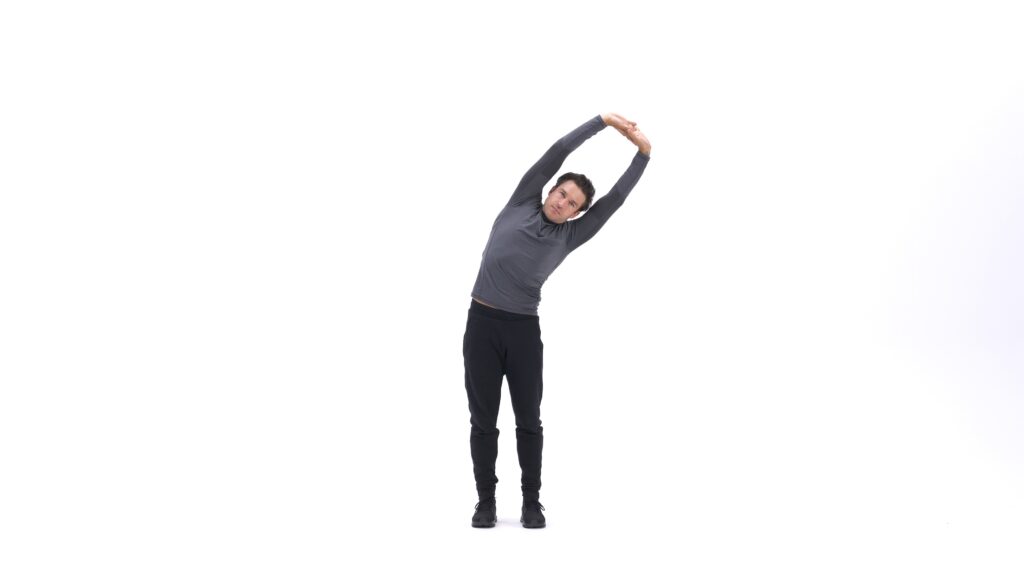
Glute Medius and Quadratus Lumborum Stretch: Figure-4 Spinal Rotation
This stretch is designed to isolate the glute medius muscle and balance the quadratus lumborum in your lower back. Often times hip problems are caused by imbalances in the spine. You will often feel the pain radiating toward the back. This stretch will help with that. You should notice a difference between the two sides. If not, you can probably skip this one.
- Lie on your back with both knees bent and your feet flat on the floor.
- Rest the ankle of your affected leg on your opposite thigh, near your knee, creating a figure-4 position.
- Maintaining this position, slowly rotate your lumbar spine so that the foot of your raised leg touches the floor.
- Now, engage your glute muscles to gently push the elevated knee down and outward.
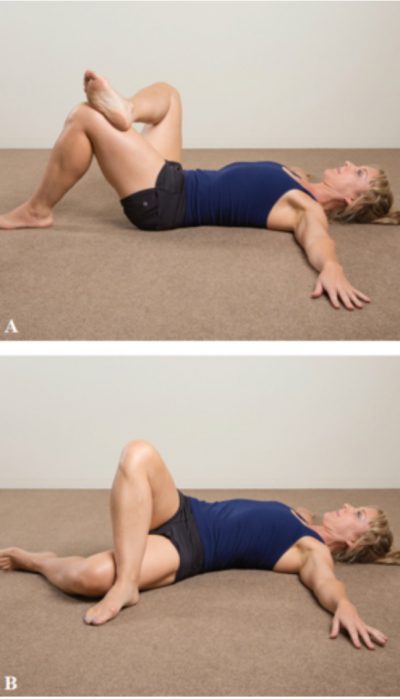
TFL Stretch: Lunge Position
This stretch focuses on the Tensor Fasciae Latae (TFL), a muscle that often becomes tight with hip bursitis. You will have pain that is a little more to the front on the hip.
- Start in a lunge position with your unaffected leg in front and your affected leg extended behind you. Ensure that both your front and back leg align with your hips.
- Shift your hips forward while squeezing your glute muscles. You should feel a stretch in the front of your hip.
- From this position, keeping your spine stable, extend your arms overhead.
- To enhance the stretch, you can add a gentle rotation of your trunk. Always use deep belly breathing to subtly increase the stretch, rather than forcing it.
Remember to keep these stretches gentle and within your comfort range. Overstretching can lead to additional pain or injury. The way to increase the stretch is by breathing deeply, not forcing it. Please consult a healthcare provider or a physiotherapist if you are unsure how to perform these stretches.
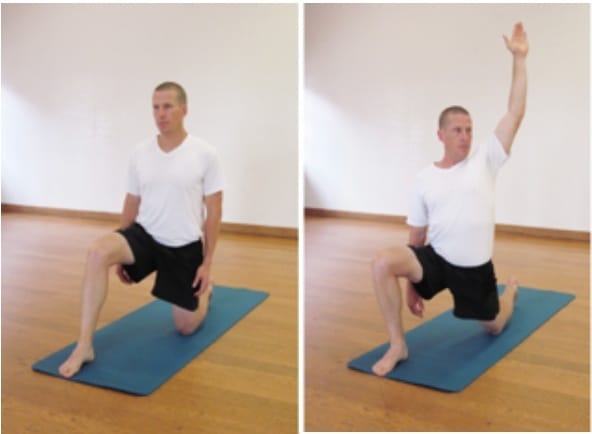
Other Things To Help Manage Hip Bursitis
Here are other strategies to effectively manage hip bursitis:
- Rest: Rest is crucial. Avoid activities that intensify your pain and ensure a steady progression when resuming exercise.
- Maintain a Healthy Weight: Extra weight can place additional stress on your hips, exacerbating bursitis.
- Regular Low-Impact Exercise:
Strength and stability are key to managing hip bursitis and keeping it for coming back. It is most important later in the healing process as the pain begins to go away. These low-impact exercises are designed to target the lateral hip muscles, promoting strength and stability in the joint without causing further discomfort.
Exercise 1: Lateral Band Walk
Lateral band walks target the gluteus medius, a key hip-stabilizing muscle.
- Stand with your feet shoulder-width apart. Place a stretchy resistance band around your ankles.
- Slightly bend your knees and squat down into a half-squat position. This is your starting position.
- Slowly step to the right while keeping the band tight. Follow with your left foot so you return to the shoulder-width stance.
- Repeat this for 10-15 steps, then switch direction and step to the left.
- Aim for 2-3 sets in each direction.
Remember to keep your posture upright and your core engaged throughout the exercise.
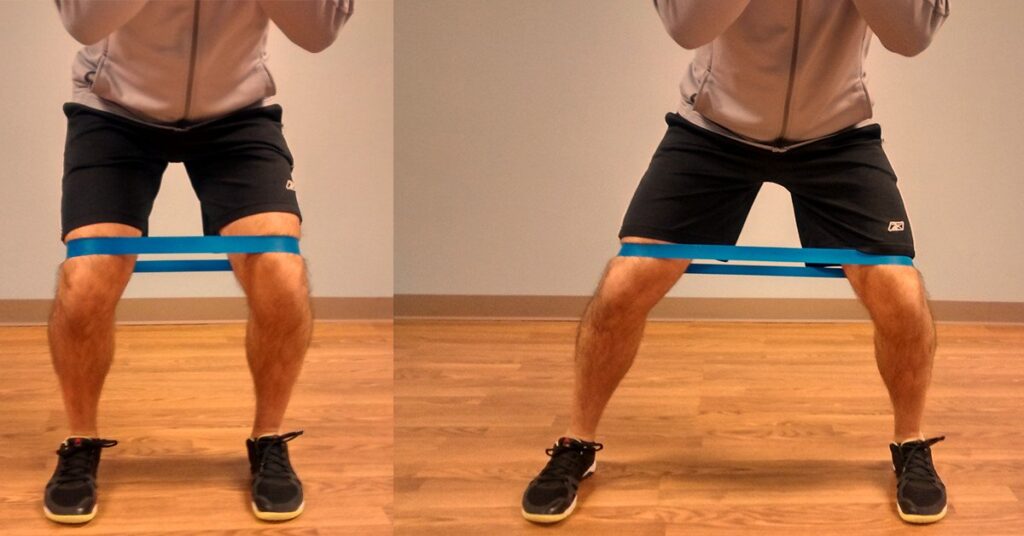
Exercise 2: Single-Leg Balance
This exercise mimics the function of the hip during walking and is a good progression as you get stronger.
- Stand near a wall or chair in case you need support.
- Shift your weight onto your unaffected leg.
- Slowly lift your affected leg off the ground, maintaining balance on your standing leg.
- Try to hold this position for 10-20 seconds, then switch to the other leg.
- Aim for 2-3 sets on each leg.
- As your balance improves, try to increase the duration of the exercise. This exercise promotes stability and strengthens the muscles supporting the hip.
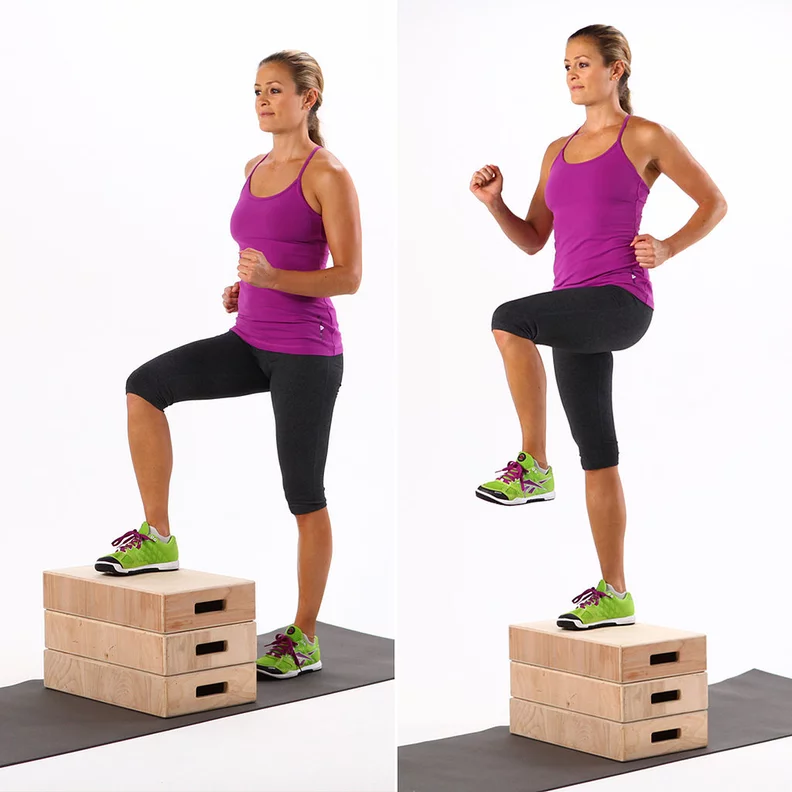
Important Note
Please consult a healthcare provider or a physical therapist if you are unsure how to perform these exercises or if they cause pain. Individual responses can vary, and these exercises might not be suitable for everyone with hip bursitis. Your healthcare provider can help tailor an exercise program specifically for your condition and fitness level.
Don’t Forget
Hip bursitis can be painful, but it can be effectively managed at home with the right knowledge and tools like Evil Bone Water. Remember, these strategies can help alleviate discomfort but should not replace professional medical advice. Should symptoms persist, please seek medical attention.
If you found this information useful and believe it could help someone you know, share this article with them. If you have questions or require more assistance, don’t hesitate to contact us. If you haven’t already tried Evil Bone Water to combat your hip bursitis, visit our store to order your supply today. We have a Power Patch combo that is perfect for this condition.
Don’t suffer in silence; gain control of your hip bursitis today! Visit our store now to order your Evil Bone Water Power Patch Combo. and start your journey towards pain-free living. Together, we can overcome the pain.
Buy Power Patch Combo Today!
Evil Bone Water (Zheng Gu Shui) is a Chinese topical medicinal hand-crafted with only empirical grade herbal ingredients in an approved facility.
Experience dual-action relief with our Evil Bone Water and Muscle Melt Patches combination. This dynamic duo promises round-the-Clock relief, combining the fast-acting power of Evil Bone Water with the long-lasting effects of Muscle Melt Patches.
.
About the Author
Willard Sheppy is a writer and healthcare practitioner who seamlessly melds scientific knowledge with practical applications in engaging and authoritative articles. He holds a Bachelor of Science in Environmental Science from Oregon State University and a Master’s in Acupuncture and Oriental Medicine from the distinguished Oregon College of Oriental Medicine.
In his work, Willard skillfully combines his extensive educational background in scientific research with his practical experience as a healthcare practitioner. Willard balances his life with martial arts and cherished family adventures. As a father of three, he often leads his family on camping and hiking trips along the breathtaking Oregon coast.
Connect with Willard on LinkedIn at linkedin.com/in/valleyhealthclinic or learn more about his services at valleyhealthclinic.com. Embark on this journey towards holistic health with Willard!


